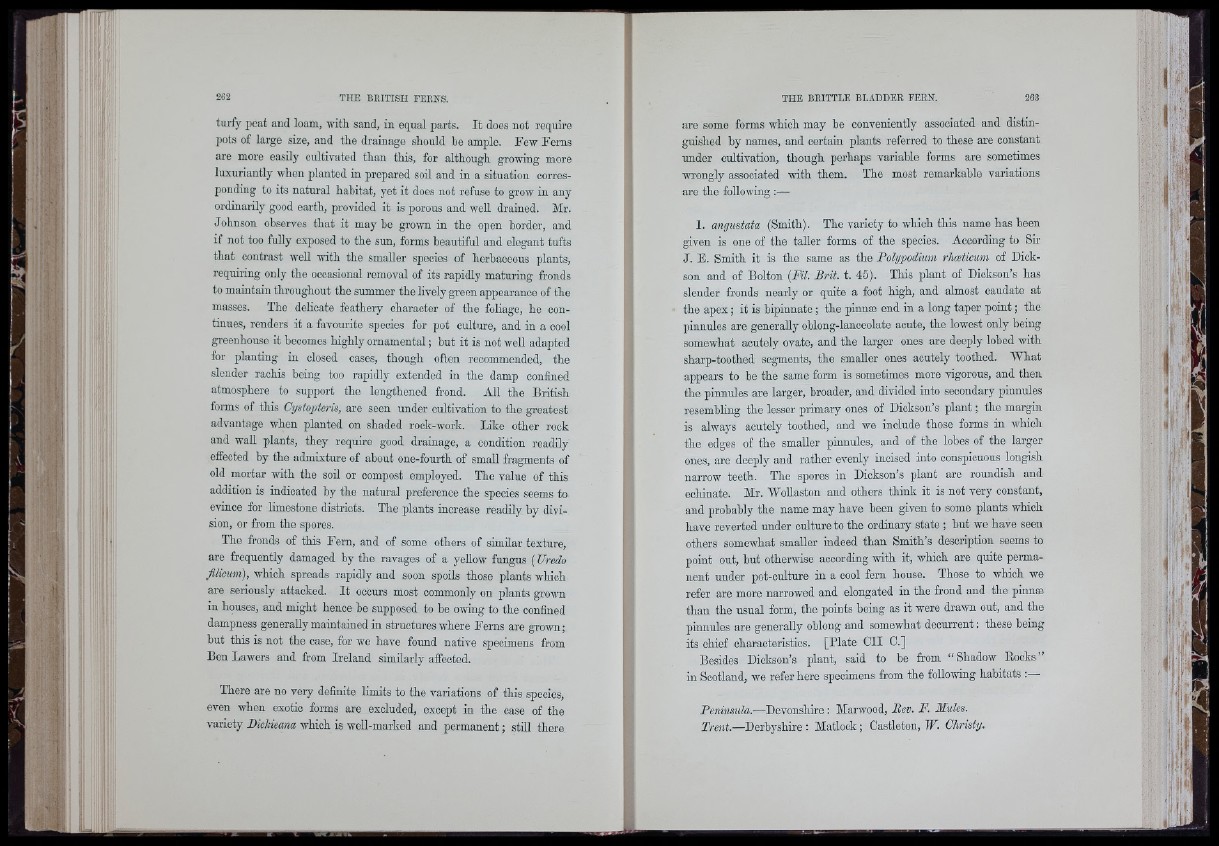
tm-fy peat aud loam, with sand, in equal parts. It does not require
pots of large size, and the drainage should be ample. Few Ferus
are more easily cultivated than this, for although growmg more
luxuriantly when planted in prepared soil and in a situation corresponding
to its natural habitat, yet it does not refuse to grow in any
ordinarily good earth, provided it is porous and well drained. Mr.
Johnson observes that it may he grown in the open border, and
if not too fully exposed to the sun, forms beautiful and elegant tufts
that contrast well w'ith the smaUer species of herbaceous plants,
requiring only the occasional removal of its rapidly maturing fronds
to maintain throughout the summer the lively green appearance of the
masses. The delicate feathery character of the foliage, he continues,
renders it a favourite species for pot culture, and in a cool
greenhouse it becomes highly ornamental; but it is not weU adapted
for planting iu closed cases, though often recommended, the
slender raohis being too rapidly extended in the damp confined
atmosphere to support the lengthened frond. All the British
forms of this Cystopteris, are seen nnder cultivation to the greatest
advantage when planted on shaded rock-work. Like other rook
and wall plants, they requUe good drainage, a condition readily
effected by the admixture of about one-fourth of smaU fragments of
old mortar with the soil or compost employed. The value of this
addition is indicated by the natural preference the species seems to
evince for Umestone districts. The plants increase readily by division,
or from the spores.
The fronds of this Fern, and of some others of similar texture,
are frequently damaged by the ravages of a yeUow fungus ( TJredo
filicum), which spreads rapidly and soon spoils those plants which
are seriously attacked. It occurs most commonly on plants grown
in houses, and might hence he supposed to be owing to the confined
dampness generaUy maintained in structures where Ferns are grown;
hut this is not the case, for we have found native specimens from
Ben Lawers and from Ireland similarly affected.
There are no very definite Umits to tho variations of this species,
even when exotic forms are excluded, except iu the case of the
variety Dickieana which is well-marked and permanent; still there
are some forms which may be conveniently associated and distinguished
hy names, and certain plants referred to these are constant
under cultivation, though perhaps variable forms are sometimes
wrongly associated with them. The most remarkable variations
are the foUowing ;—
1. angustata (Smith). The variety to which this name has been
given is one of the taUer forms of the species. According to Sir
J. E. Smith it is the same as the Polypodium rhæticum, of Dickson
and of Bolton {Fil. Brit. t. 45). This plant of Dickson’s has
slender fronds nearly or quite a foot high, and almost caudate at
the apex ; it is bipinnate ; the piuuæ end in a long taper point ; tho
pinnules are generaUy oblong-lanceolate acute, tho lowest only being
somewhat acutely ovate, and the larger ones are deeply lobed with
sharp-toothed segments, the smaUer ones acutely toothed. What
appears to be the same form is sometimes more vigorous, and then
the pinnules are larger, broader, and divided into secondary pinnules
resembling the lesser primary ones of Dickson’s plant ; the margin
is always acutely toothed, and we include those forms in which
the edges of the smaller pinnules, and of the lobes of the larger
ones, are deeply and rather evenly incised into conspicuous longish
narrow teeth. The spores in Dickson’s plant aro roundish and
echinate. Mr. WoUaston and others think it is not very constant,
and probably the name may have been given to some plants which
have reverted under culture to the ordinary state ; hut we have seen
others somewhat smaUer indeed than Smith’s description seems to
point out, but otherwise according with it, which are quite permanent
under pot-culture in a cool fern house. Those to which we
refer are more narrowed and elongated in the frond and the pinnæ
than the usual form, the points heing as it were draYvu out, and the
pinnules are generally oblong and somewhat deourrent : these heing
its chief characteristics. [Plate CII C.]
Besides Dickson’s plant, said to be from “ Shadow Eocks”
in Scotland, we refer here specimens from the following habitats : •
Peninsula.—Devonshire ; Marwood, Rev. F. Mules.
Trent.—Derbyshire : Matlock ; Castleton, W. Christy.
iri,:
I
i:
A
ill
i'l
fi
i .
:î